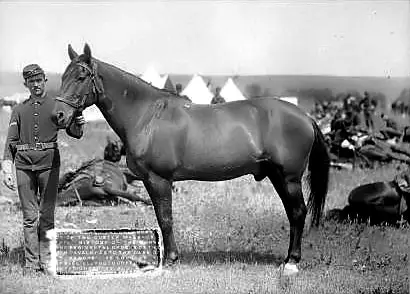My first car was a 1984 Chevy El Camino. I loved that car … or truck; depending on from what angle you were looking at it. The exterior was two shades of gray, the interior the same muted color, and one of my earliest memories of it was the road trip we took to California to drive it home.
You might be wondering how on Earth this relates to horses and history, but just wait. I do have a point!
Since we had two cars to drive home at the end of our visit, my brother and I switched cars at each pit stop on the 12-hour drive home to Washington, and the El Camino was definitely the cool place to be. Not because of the car itself, but because of the music blasting out of the speakers. The one and only Johnny Horton. I know, totally old school, but to my brother and I, he was awesome, and we bickered over who got to take the tape during the entire trip. My Dad, bless his soul, laid down the law and kept it in the truck with him. I doubt he wanted to listen to Johnny after that!
OK, OK, back to the point. Horses. History. Johnny Horton sings this song called “Comanche (The Brave Horse),” a lovely ballad about the great warhorse, Comanche, who was one of the sole survivors of the Battle of Little Big Horn way back in 1876.
Now, Comanche was one of those horses who was something special despite all the obstacles life tossed at him. He was born around 1862, was captured in a wild horse roundup, gelded and sold to the U.S. Army Cavalry on April 3, 1868, only stood 15 hands and had a knack for getting wounded in battle. In fact, he was named “Comanche” after he was shot in the hindquarters with an arrow while fighting the Comanche in Kansas in 1868. Even after the injury, he continued to partake in the battle and carried his owner, Captain Myles Keogh, to victory.
One common misconception about Comanche’s life is that Lieutenant Colonel George Armstrong Custer rode him during the Battle of Little Big Horn. That, however, was not the case. Comanche carried his owner, Captain Keogh, who, along with the entire detachment, was killed on June 25, 1876.
According to legend, Keogh crouched between Comanche’s legs and held onto his reins while he was fighting. When he died, he was still holding onto him. The Lakota and Northern Cheyenne warriors left Comanche alone because they believed it was bad luck to take a horse that was so close with his owner, even in death. Comanche was also badly wounded in the battle.
Comanche was transported to Fort Lincoln when he was discovered by reinforcements two days after the battle and was nursed back to health. He was retired from active duty in April of 1878. He was taken to Fort Mead in June of 1879, where he was treated like royalty until he moved to Fort Riley (Kan.) in 1887. He lived at Fort Riley until his death on Nov. 7, 1891. He is one of only two horses (the other being Black Jack) to be buried with full military honors.
ADVERTISEMENT
After his death, Comanche was stuffed and put on display at the University of Kansas. While Comanche has always been referred to as the only survivor of the Battle of Little Big Horn, historians know that quite a few of the Seventh Cavalry mounts survived. However, Comanche, the brave horse, is the only one who can still be viewed today. So in some ways, the sentiment is true!
Unfortunately, my El Camino didn’t last nearly as long as Comanche. It led a great life, though, pulling my horse trailer and taking care of one busy teenager! As the miles added up (nearly 300,000 at the end), and the interior fell apart, and you had to pump the gas pedal, rev the engine, let it warm-up for 10 minutes, then rev the engine down before you drove it, we knew it was time to let it go.
My brother and I were home for Christmas when the El Camino rode off into the sunset. We both stood on the back porch and waved goodbye when it was towed away, and there was even a sad moment or two as the truck/car disappeared from view. But then we went inside, dug through the mountains of cassette tapes my mother has hoarded over the years, and spent the afternoon rocking out to the one and only Johnny Horton.
“Comanche (The Brave Horse)”
by Johnny Horton
The battle was over at Custer’s last stand
And Taps were sounding for all the brave men
While one lone survivor wounded and weak
Comanche the Brave Horse laid at the General’s feet
Comanche you fought hard, Comanche you tried
You were a good soldier so hold your head up high
For even the greatest sometimes must fall
Comanche the Brave Horse you gave your all
Though you are silent your deeds did speak loud
If your buddies could see you I know they’d be proud
The symbol of bravery at the Little Big Horn
Poor old Comanche you’re battle scarred and worn
Comanche you fought hard…
Comanche you fought hard…















